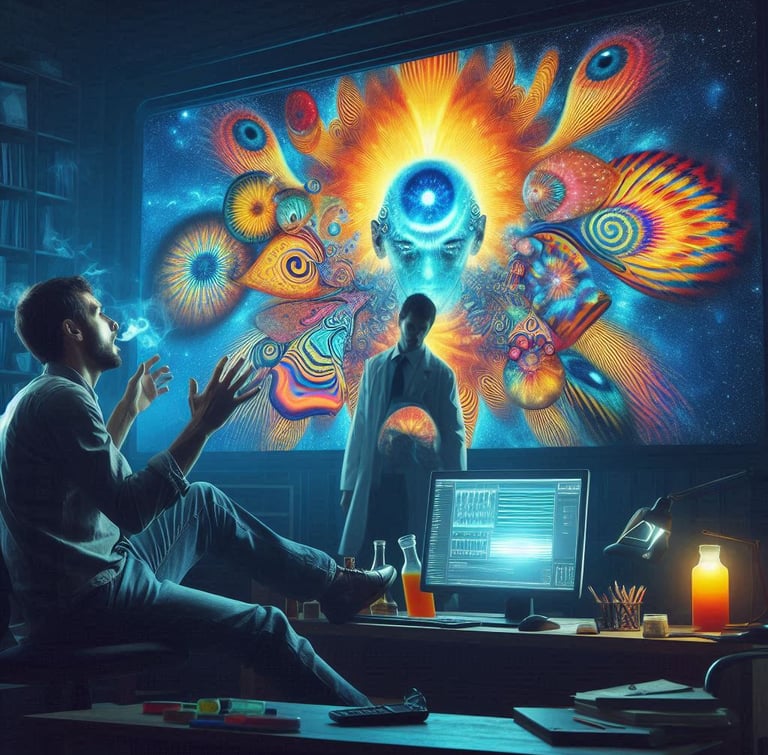Stay updated on what is trending in health. Discover tips and resources for a healthier, balanced life.
HPPD: A Persistent Neurological Effect of Psychedelic Substances
Learn about HPPD (Hallucinogen Persisting Perception Disorder), a rare but real neurological condition causing lasting visual disturbances after psychedelic use. Discover symptoms, causes, and evidence-based management strategies.
MENTAL HEALTH
Dr. S. Ali
5/11/20253 min read


Have you ever heard of someone still seeing trails, flashes, or visual static long after their psychedelic trip ended? For some, the effects of hallucinogens don’t fully fade—instead, they develop a rare but real condition called HPPD (Hallucinogen Persisting Perception Disorder).
In this post, we’ll break down:
What HPPD feels like (and how it’s different from a "flashback")
Why it happens—the science behind persistent hallucinations
Treatment options (yes, there’s hope for improvement)
Let’s dive in.
What Does HPPD Actually Feel Like?
Individuals with HPPD often describe experiencing persistent visual disturbances long after their psychedelic experience has ended. Months or even years later, they may notice:
A constant visual snow effect, resembling static on an old television
Trailing images where moving objects leave faint afterimages
Enhanced colors and patterns appearing spontaneously in their field of vision
Increased light sensitivity, making normal lighting appear harsh or overwhelming
For some, these symptoms remain mild - a barely noticeable quirk of perception. Others find them significantly distressing, particularly when accompanied by:
Feelings of depersonalization or derealization (a sense of detachment from reality)
Heightened anxiety about their altered perception
A key distinction from drug flashbacks is that HPPD symptoms:
Are constant rather than episodic
Occur without the cognitive or emotional effects of being high
The experience has been likened to having one's visual processing permanently shifted toward a psychedelic state - not enough to induce an actual trip, but sufficient to make ordinary perception feel subtly altered.
Symptom severity exists on a spectrum, with some individuals adapting easily while others find the changes significantly impact daily functioning.
Why Does HPPD Happen?
Researchers aren’t 100% sure, but leading theories suggest:
Serotonin system disruption (psychedelics heavily affect 5-HT2A receptors, which regulate perception).
Hyperactive visual cortex (the brain’s "visual processor" gets stuck in overdrive).
Pre-existing vulnerability (people with anxiety, migraines, or a history of drug sensitivity may be more at risk).
Most Likely to Occur With:
HPPD is most commonly associated with classic psychedelics and related substances, particularly when used in high doses or frequently. While it can theoretically develop after any hallucinogenic experience, certain compounds appear to carry a higher risk based on anecdotal reports and clinical observations.
The condition seems particularly linked to:
Serotonergic psychedelics (substances that strongly activate the 5-HT2A receptors)
Empathogens with psychedelic properties
Research chemicals and synthetic analogs
Patterns suggest that frequency of use and dosage play significant roles, with repeated exposures and high-potency experiences increasing susceptibility. However, cases have been reported even after single exposures in susceptible individuals.
Can HPPD Be Managed?
While no definitive cure exists, many individuals experience gradual improvement through a combination of approaches:
Medical Interventions
Certain prescribed medications have shown promise in reducing symptoms by helping regulate neurological activity. These may include:
Neuromodulators that stabilize neural signaling
Medications targeting co-occurring anxiety (though response varies)
Adaptive Strategies
Lifestyle modifications often prove beneficial:
Complete abstinence from mind-altering substances
Implementation of stress-management techniques
Prioritization of restorative sleep and proper hydration
Natural Progression
For many affected individuals, symptoms naturally diminish in intensity over extended periods, with perceptual disturbances becoming less intrusive with time.
Important Considerations
Treatment approaches should always be guided by medical professionals familiar with the condition, as individual responses to interventions can vary significantly. The most effective strategies typically combine professional support with consistent self-care practices.
Key Takeaways About HPPD
HPPD represents a genuine, though uncommon, neurological condition resulting from psychedelic substance use. Importantly, these persistent perceptual changes have a biological basis and are not merely psychological. While the experience can be unsettling, the prognosis is often positive with proper management.
For Those Experiencing Symptoms
Professional guidance is strongly recommended:
Consult with a specialist in neurological or psychiatric care
Refrain from unsupervised attempts at symptom management
Consider connecting with others experiencing similar challenges through dedicated support networks
A Note of Reassurance
Clinical observations suggest that most individuals see gradual improvement when combining professional support with healthy lifestyle choices. The condition often becomes less intrusive over time with appropriate care and patience.
Sources:
National Institute on Drug Abuse (NIDA) – https://www.drugabuse.gov
American Psychiatric Association (DSM-5) – https://www.psychiatry.org
PubMed Central (NIH) – https://www.ncbi.nlm.nih.gov/pmc/
DrugScience – https://www.drugscience.org.uk
Journal of Clinical Medicine – HPPD Studies – https://www.mdpi.com/journal/jcm
Pulse Your Health
Empowering you to achieve your health goals.
Contact
© 2025. All rights reserved.
Disclaimer: The content on this website is for informational purposes only and is not medical advice. Always seek the advice of your physician or other suitably qualified healthcare professional for diagnosis, treatment and your health related needs.
